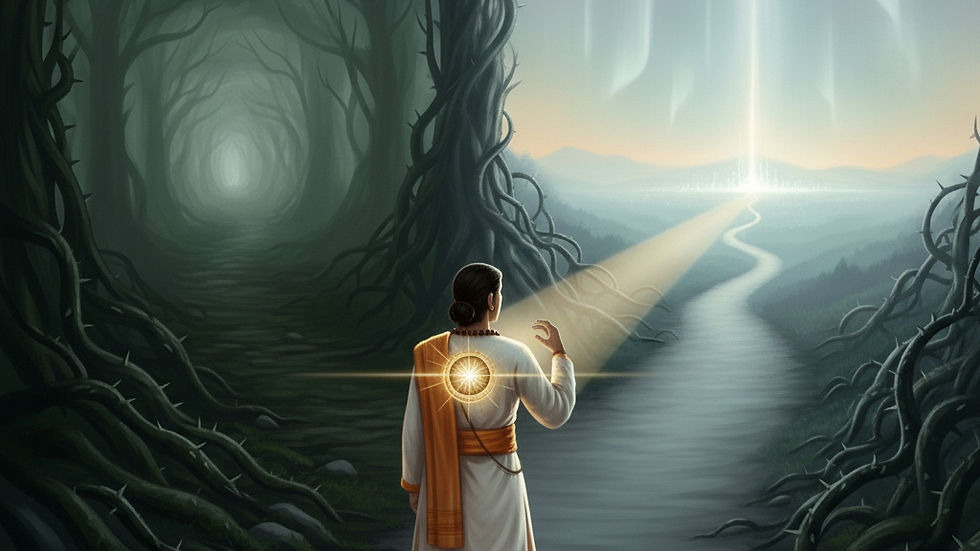Living in Harmony with Nature: A Sacred Dharma
- H.H. Raseshwari Devi Ji

- Aug 8
- 4 min read
Updated: Sep 10

Introduction: A Forgotten Vow
In our pursuit of advancement, we have mistaken dominance for destiny. But the ancients knew better. They taught us: we are not separate from nature — we are her children, her stewards, and her servants.
Every breeze that cools us, every leaf that feeds us, every drop that quenches us — these are not conveniences. They are sacred offerings from Mother Earth. To live in harmony with her is not a lifestyle choice. It is our dharma — our highest responsibility and our greatest privilege.
This is not a call to return to the past. It is a return to wisdom.
Nature in Sanātana Dharma: Sacred, Not Separate
In the worldview of the ṛṣis (sages), the universe was not fragmented. Nature was not a “resource.” She was divine — infused with consciousness, śakti, and prāṇa. Trees were teachers. Rivers were mothers. Mountains were ancestors. Even the soil was sacred.
ईशावास्यमिदं सर्वं यत्किञ्च जगत्यां जगत्। “Ishavasyam idam sarvam yat kiñca jagatyām jagat”
—Isha Upanishad
All that moves and does not move in this world is pervaded by the Divine.
This is a principle. If all is Divine, then to serve nature is to serve God. To exploit her without restraint is not just ignorance — it is adharma.
A Dharma We Have Forgotten
The earth does not belong to us. We belong to her. And so, our dharma is not conquest, but balance. Not consumption, but care. Not profit, but protection. This is the true seva — the selfless service that uplifts not just humanity, but all beings.
“सर्वं खल्विदं ब्रह्म” “Sarvam khalv idam brahma”
—Chāndogya Upanishad 7.26.2
All this is Brahman. The trees, the rivers, the air — they are not objects, they are expressions of the sacred.
Signs of Separation: When Dharma Breaks
Today, when we see:
🌳 Forests falling like leaves in a storm
🐾 Species vanishing without farewell
🌡️ Temperatures rising like unchecked desire
😔 Depression, disconnection, and anxiety taking root in human hearts
…it is not merely an ecological crisis. It is a crisis of dharma. When we forget our sacred duty to protect life, we lose our connection to life itself — and with it, our peace.
Five Pillars of Sacred Relationship with Nature
Let us not wait for catastrophe to remind us of our vows. Let us rebuild our bond with Prakṛti through sacred values:
Seva (Selfless Service)
Serve nature not as an act of charity, but of devotion. Plant trees not just for shade, but as worship. Clean rivers as you would bathe a deity.
Sensitivity (Karunā)
Treat every living being as a soul with purpose. A cow, a crow, a creeping vine — all are part of God’s family. To walk gently is to walk spiritually.
Balance (Samatā)
Resist the extremes of greed and guilt. Use what you need — no more, no less. Let your lifestyle be guided by harmony, not hunger.
Gratitude (Kṛtajñatā)
Begin every meal with thanks. Before cutting a tree or drawing water, offer a prayer. Gratitude sanctifies every act.
Responsibility (Kartavya Bhāva)
We are the only species that can protect all others — or destroy them. That power is not a privilege. It is a test of our soul.
Conclusion: To Protect the Earth Is to Protect Dharma
Nature is not asking us to save her. She is asking us to remember who we are.
We are not owners. We are not consumers. We are guardians, devotees, co-creators in the divine play of life.
“अन्नं न निन्द्यात् तद्व्रतम्।” “Annam na nindyāt tad vratam”
—Taittirīya Upanishad 3.10.4
“Do not revile food — that is the vow.”
Let us expand this vow to include every tree, every river, every being. To protect them is not just wise — it is holy. It is human. May we restore the sacred bond between man and nature, action and reverence, life and dharma.
With reverence and responsibility,
Radhe Radhe,
— Raseshwari Devi Ji
Further Reading:
(Environmental Role: Responsibility and Stewardship)
“मानव जीवन में प्रकृति का महत्व” (Importance of Nature in Human Life)
“जीवन में पर्यावरणीय जिम्मेदारी” (Environmental Responsibility in Life)
“मानव जीवन और वृक्षों का महत्व” (The Value of Trees in Human Life)
“प्रकृति के साथ सामंजस्य: मानव का धर्म” (Harmony with Nature: A Human Duty)
“प्रकृति संरक्षण के बिना मानव जीवन अधूरा है” (Human Life Is Incomplete Without Nature Conservation)
Frequently Asked Questions (FAQs)
Q1. Why is harmony with nature considered dharma?
Because it sustains ṛta — the cosmic order. Without balance in nature, spiritual and physical life collapses. Protecting nature is a moral and spiritual necessity.
Q2. Is this just an ancient idea, or is it practical today?
It is deeply ancient and urgently modern. Both science and spirituality now agree — harmony with ecosystems is essential for survival and wellbeing.
Q3. How can I practice this dharma daily?
Use water, fuel, and food mindfully
Respect all life, including animals and plants
Volunteer for reforestation or cleanup efforts
Teach reverence for nature to children
Q4. What if I live in a city with limited access to nature?
Nature is not distant. It is in the air you breathe, the food you eat, the birds on your windowsill. You can practice gratitude and restraint even in urban spaces.
Q5. Can businesses follow this dharma too?
Absolutely. Ethical sourcing, carbon responsibility, biodiversity support — all can become corporate yajñas (sacrifices) for the greater good. This is not profit versus planet — it is profit through dharma.





















Comments